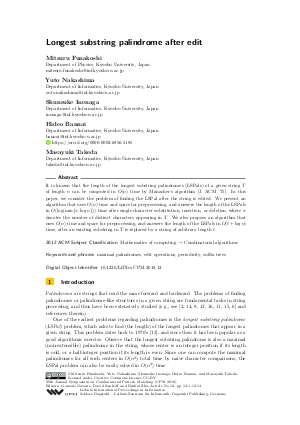Longest substring palindrome after edit
Authors
Mitsuru Funakoshi,
Yuto Nakashima,
Shunsuke Inenaga,
Hideo Bannai  ,
Masayuki Takeda
,
Masayuki Takeda
-
Part of:
Volume:
29th Annual Symposium on Combinatorial Pattern Matching (CPM 2018)
Part of: Series: Leibniz International Proceedings in Informatics (LIPIcs)
Part of: Conference: Annual Symposium on Combinatorial Pattern Matching (CPM) - License:
 Creative Commons Attribution 3.0 Unported license
Creative Commons Attribution 3.0 Unported license
- Publication Date: 2018-05-18
File

PDF
LIPIcs.CPM.2018.12.pdf
- Filesize: 0.56 MB
- 14 pages
Document Identifiers
Subject Classification
ACM Subject Classification
- Mathematics of computing → Combinatorial algorithms
Keywords
- maximal palindromes
- edit operations
- periodicity
- suffix trees
Metrics
- Access Statistics
-
Total Accesses (updated on a weekly basis)
0Document
0Metadata
Abstract
It is known that the length of the longest substring palindromes (LSPals) of a given string T of length n can be computed in O(n) time by Manacher's algorithm [J. ACM '75]. In this paper, we consider the problem of finding the LSPal after the string is edited. We present an algorithm that uses O(n) time and space for preprocessing, and answers the length of the LSPals in O(log (min {sigma, log n })) time after single character substitution, insertion, or deletion, where sigma denotes the number of distinct characters appearing in T. We also propose an algorithm that uses O(n) time and space for preprocessing, and answers the length of the LSPals in O(l + log n) time, after an existing substring in T is replaced by a string of arbitrary length l.
Cite As Get BibTex
Mitsuru Funakoshi, Yuto Nakashima, Shunsuke Inenaga, Hideo Bannai, and Masayuki Takeda. Longest substring palindrome after edit. In 29th Annual Symposium on Combinatorial Pattern Matching (CPM 2018). Leibniz International Proceedings in Informatics (LIPIcs), Volume 105, pp. 12:1-12:14, Schloss Dagstuhl – Leibniz-Zentrum für Informatik (2018)
https://doi.org/10.4230/LIPIcs.CPM.2018.12
BibTex
@InProceedings{funakoshi_et_al:LIPIcs.CPM.2018.12,
author = {Funakoshi, Mitsuru and Nakashima, Yuto and Inenaga, Shunsuke and Bannai, Hideo and Takeda, Masayuki},
title = {{Longest substring palindrome after edit}},
booktitle = {29th Annual Symposium on Combinatorial Pattern Matching (CPM 2018)},
pages = {12:1--12:14},
series = {Leibniz International Proceedings in Informatics (LIPIcs)},
ISBN = {978-3-95977-074-3},
ISSN = {1868-8969},
year = {2018},
volume = {105},
editor = {Navarro, Gonzalo and Sankoff, David and Zhu, Binhai},
publisher = {Schloss Dagstuhl -- Leibniz-Zentrum f{\"u}r Informatik},
address = {Dagstuhl, Germany},
URL = {https://drops.dagstuhl.de/entities/document/10.4230/LIPIcs.CPM.2018.12},
URN = {urn:nbn:de:0030-drops-86977},
doi = {10.4230/LIPIcs.CPM.2018.12},
annote = {Keywords: maximal palindromes, edit operations, periodicity, suffix trees}
}
Author Details
References
-
Amihood Amir, Panagiotis Charalampopoulos, Costas S. Iliopoulos, Solon P. Pissis, and Jakub Radoszewski. Longest common factor after one edit operation. In SPIRE 2017, pages 14-26, 2017.

-
Alberto Apostolico, Dany Breslauer, and Zvi Galil. Parallel detection of all palindromes in a string. Theoretical Computer Science, 141:163-173, 1995.

-
Michael A. Bender and Martin Farach-Colton. The LCA problem revisited. In LATIN 2000, pages 88-94, 2000.

-
Richard Cole and Ramesh Hariharan. Dynamic LCA queries on trees. SIAM J. Comput., 34(4):894-923, 2005.

-
Martin Farach-Colton, Paolo Ferragina, and S. Muthukrishnan. On the sorting-complexity of suffix tree construction. J. ACM, 47(6):987-1011, 2000.

-
Pawel Gawrychowski, Tomohiro I, Shunsuke Inenaga, Dominik Köppl, and Florin Manea. Tighter bounds and optimal algorithms for all maximal α-gapped repeats and palindromes - finding all maximal α-gapped repeats and palindromes in optimal worst case time on integer alphabets. Theory Comput. Syst., 62(1):162-191, 2018.

-
Leszek Ga̧sieniec, Marek Karpinski, Wojciech Plandowski, and Wojciech Rytter. Efficient algorithms for Lempel-Ziv encoding. In Proc. 5th Scandinavian Workshop on Algorithm Theory (SWAT1996), volume 1097 of LNCS, pages 392-403. Springer, 1996.

-
Richard Groult, Élise Prieur, and Gwénaël Richomme. Counting distinct palindromes in a word in linear time. Inf. Process. Lett., 110(20):908-912, 2010.

-
Dan Gusfield. Algorithms on Strings, Trees, and Sequences. Cambridge University Press, 1997.

-
Dov Harel and Robert Endre Tarjan. Fast algorithms for finding nearest common ancestors. SIAM J. Comput., 13(2):338-355, 1984.

-
Roman Kolpakov and Gregory Kucherov. Searching for gapped palindromes. Theor. Comput. Sci., 410(51):5365-5373, 2009.

-
Dmitry Kosolobov, Mikhail Rubinchik, and Arseny M. Shur. Finding distinct subpalindromes online. In Proceedings of the Prague Stringology Conference 2013, Prague, Czech Republic, September 2-4, 2013, pages 63-69, 2013.

-
Glenn Manacher. A new linear-time "on-line" algorithm for finding the smallest initial palindrome of a string. Journal of the ACM, 22:346-351, 1975.

-
W. Matsubara, S. Inenaga, A. Ishino, A. Shinohara, T. Nakamura, and K. Hashimoto. Efficient algorithms to compute compressed longest common substrings and compressed palindromes. Theor. Comput. Sci., 410(8-10):900-913, 2009.

-
Shintaro Narisada, Diptarama, Kazuyuki Narisawa, Shunsuke Inenaga, and Ayumi Shinohara. Computing longest single-arm-gapped palindromes in a string. In SOFSEM 2017, pages 375-386, 2017.

-
Alexandre H. L. Porto and Valmir C. Barbosa. Finding approximate palindromes in strings. Pattern Recognition, 35:2581-2591, 2002.

-
Baruch Schieber and Uzi Vishkin. On finding lowest common ancestors: Simplification and parallelization. SIAM J. Comput., 17(6):1253-1262, 1988.

-
E. Ukkonen. On-line construction of suffix trees. Algorithmica, 14(3):249-260, 1995.

-
Peter Weiner. Linear pattern matching algorithms. In 14th Annual Symposium on Switching and Automata Theory, pages 1-11, 1973.

